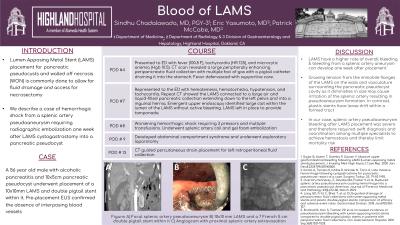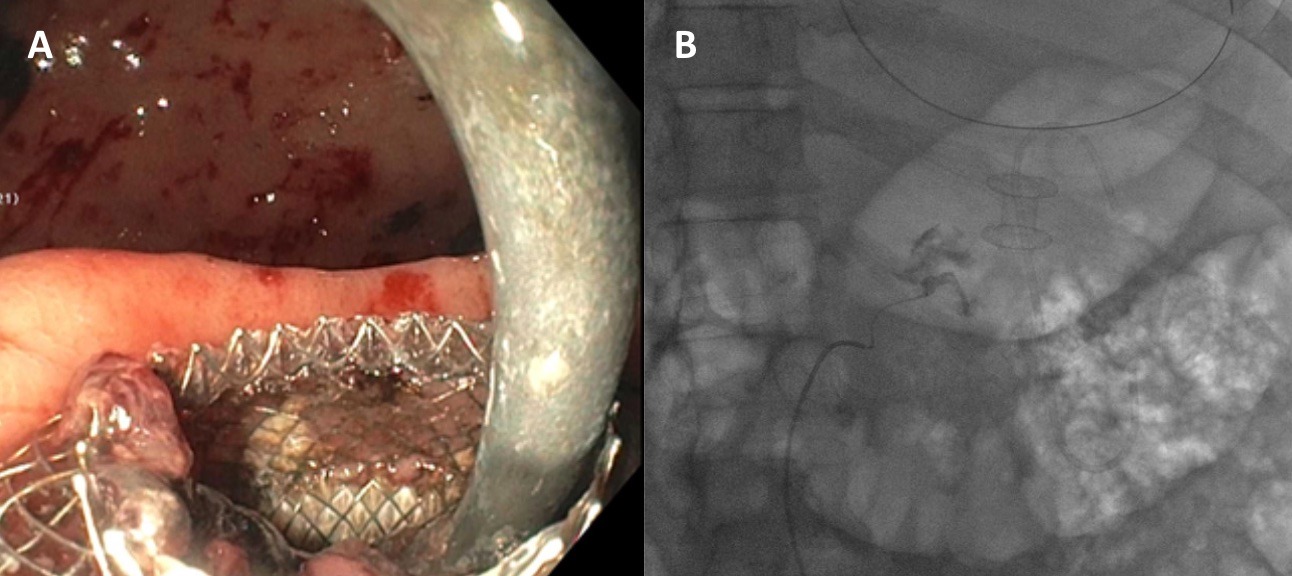Monday Poster Session
Category: Interventional Endoscopy
P2319 - Blood of LAMS
Monday, October 23, 2023
10:30 AM - 4:15 PM PT
Location: Exhibit Hall

Has Audio

Sindhu Chadalawada, MD
Alameda Health System - Highland Hospital
Oakland, CA
Presenting Author(s)
Sindhu Chadalawada, MD, Eric Yasumoto, MD, Patrick McCabe, MD
Alameda Health System - Highland Hospital, Oakland, CA
Introduction: Lumen Apposing Metal Stent (LAMS) placement for pancreatic pseudocysts and walled off necrosis (WON) is commonly done to allow for fluid drainage and access for necrosectomy. We describe a rare case of hemorrhagic shock from a splenic artery pseudoaneurysm requiring radiographic embolization one week after LAMS cystgastrostomy in a pancreatic pseudocyst.
Case Description/Methods: A 56-year-old male with alcoholic pancreatitis complicated by a pseudocyst underwent LAMS placement with a double pigtail stent within it. Pre-placement EUS confirmed the absence of interposing blood vessels. Four days after placement, he presented to the emergency room with a three-day history of headache and upper respiratory congestion. He was found to have a low-grade fever, tachycardia and hemoglobin of 10.5 g/dL. Computed tomography (CT) revealed a large peripherally enhancing peripancreatic fluid collection with multiple foci of gas and a pigtail catheter draining it into the stomach. The patient improved with supportive care and was discharged. Three days later, he re-presented with hematemesis, hematochezia, hypotension and tachycardia. Repeat imaging showed the LAMS connected to a large air and liquid-filled pancreatic collection extending down to the left pelvis and into an inguinal hernia. Upper endoscopy identified large clot within the lumen of the LAMS without active bleeding. The LAMS was left in place to provide tamponade. Subsequent angiogram demonstrated irregular contour of the proximal splenic artery with small amounts of extravasation, prompting coil and gel foam embolization.
Discussion: Small studies have shown that LAMS have a higher rate of overall bleeding, including from splenic artery pseudoaneurysms rather than double-pigtail plastic stent (DPPS) placement1,2. A proposed mechanism for pseudoaneurysm formation may be that growing tension from the immobile flanges of the LAMS on the walls and vasculature surrounding the pancreatic pseudocyst cavity as it diminishes in size may cause irritation of the splenic artery. In contrast, plastic stents have loose drift within a formed tract as the pseudocyst cavity shrinks. Bleeding from a splenic artery aneurysm can develop one week after placement, and some studies have suggested an average of 18 days to one month. In our case, splenic artery pseudoaneurysm bleeding after LAMS placement was severe and therefore required swift diagnosis and coordination among multiple specialists to achieve hemostasis and thereby limit mortality risk.

Disclosures:
Sindhu Chadalawada, MD, Eric Yasumoto, MD, Patrick McCabe, MD. P2319 - Blood of LAMS, ACG 2023 Annual Scientific Meeting Abstracts. Vancouver, BC, Canada: American College of Gastroenterology.
Alameda Health System - Highland Hospital, Oakland, CA
Introduction: Lumen Apposing Metal Stent (LAMS) placement for pancreatic pseudocysts and walled off necrosis (WON) is commonly done to allow for fluid drainage and access for necrosectomy. We describe a rare case of hemorrhagic shock from a splenic artery pseudoaneurysm requiring radiographic embolization one week after LAMS cystgastrostomy in a pancreatic pseudocyst.
Case Description/Methods: A 56-year-old male with alcoholic pancreatitis complicated by a pseudocyst underwent LAMS placement with a double pigtail stent within it. Pre-placement EUS confirmed the absence of interposing blood vessels. Four days after placement, he presented to the emergency room with a three-day history of headache and upper respiratory congestion. He was found to have a low-grade fever, tachycardia and hemoglobin of 10.5 g/dL. Computed tomography (CT) revealed a large peripherally enhancing peripancreatic fluid collection with multiple foci of gas and a pigtail catheter draining it into the stomach. The patient improved with supportive care and was discharged. Three days later, he re-presented with hematemesis, hematochezia, hypotension and tachycardia. Repeat imaging showed the LAMS connected to a large air and liquid-filled pancreatic collection extending down to the left pelvis and into an inguinal hernia. Upper endoscopy identified large clot within the lumen of the LAMS without active bleeding. The LAMS was left in place to provide tamponade. Subsequent angiogram demonstrated irregular contour of the proximal splenic artery with small amounts of extravasation, prompting coil and gel foam embolization.
Discussion: Small studies have shown that LAMS have a higher rate of overall bleeding, including from splenic artery pseudoaneurysms rather than double-pigtail plastic stent (DPPS) placement1,2. A proposed mechanism for pseudoaneurysm formation may be that growing tension from the immobile flanges of the LAMS on the walls and vasculature surrounding the pancreatic pseudocyst cavity as it diminishes in size may cause irritation of the splenic artery. In contrast, plastic stents have loose drift within a formed tract as the pseudocyst cavity shrinks. Bleeding from a splenic artery aneurysm can develop one week after placement, and some studies have suggested an average of 18 days to one month. In our case, splenic artery pseudoaneurysm bleeding after LAMS placement was severe and therefore required swift diagnosis and coordination among multiple specialists to achieve hemostasis and thereby limit mortality risk.

Figure: A) 10x10 mm LAMS and a 7 French 5 cm double pigtail stent within it B) Angiogram with proximal splenic artery extravasation
Disclosures:
Sindhu Chadalawada indicated no relevant financial relationships.
Eric Yasumoto indicated no relevant financial relationships.
Patrick McCabe indicated no relevant financial relationships.
Sindhu Chadalawada, MD, Eric Yasumoto, MD, Patrick McCabe, MD. P2319 - Blood of LAMS, ACG 2023 Annual Scientific Meeting Abstracts. Vancouver, BC, Canada: American College of Gastroenterology.
